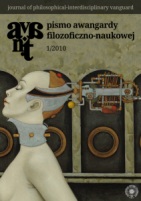Złożoność wokół nas. Część pierwsza: gra w chaos
Complexity is around us. Part one: the chaos game
Author(s): Dawid LubiszewskiSubject(s): Photography
Published by: Ośrodek Badań Filozoficznych
Summary/Abstract: Complex phenomena – like structures or processes – are intriguing scientists around the world. There are many reasons why complexity is a popular topic of research but I am going to describe just three of them. The first one seems to be very simple and says “we live in a complex world”. However complex phenomena not only exist in our environment but also inside us. Probably due to our brain with millions of neurons and many more neuronal connections we are the most complex things in the universe. Therefore by understanding complex phenomena we can better understand ourselves. On the other hand studying complexity can be very interesting because it surprises scientists at least in two ways. The first way is connected with the moment of discovery. When scientists find something new e.g. life-like patterns in John Conway’s famous cellular automata The Game of Life (Gardner 1970) they find it surprising: In Conway's own words, When we first tracked the R-pentamino... some guy suddenly said "Come over here, there's a piece that's walking!" We came over and found the figure...(Ilachinski 2001). However the phenomenon of surprise is not only restricted to scientists who study something new. Complexity can be surprising due to its chaotic nature. It is a well known phenomenon, but restricted to a special class of complex systems and it is called the butterfly effect
Journal: AVANT. Pismo Awangardy Filozoficzno-Naukowej
- Issue Year: 2010
- Issue No: 1
- Page Range: 257-271
- Page Count: 15
- Language: English

